Yesterday I met with a prospective mentor for the third semester, Phillis Ideal. I have to share a great resource for those of us far from New York: The James Kalm Report.
James Kalm takes a video camera with him to gallery shows in New York, providing commentary along the way. If you can't be there, it's an amazing glimpse into parts of the New York art scene.
Here's the official description:
James Kalm is a working artist living in Brooklyn New York. He has been an active critic for over twelve years writing for the controversial Brooklyn Rail http://brooklynrail.org/. For more high resolution videos, writings by James Kalm and views of the paintings of Loren Munk visit http://www.lorenmunk.com/.
Here's where you can go to see the videos:
BlipTV: http://jameskalmreport.blip.tv/
YouTube: The James Kalm Report
Website: Loren Munk.com
Saturday, November 28, 2009
Wednesday, November 25, 2009
Could it be procrastination?
So far today I've run with the dogs -- twice -- did 45 minutes of pilates, shredded a two-foot high stack of papers and tossed other junk, organized my collage stuff and other art paper and stuff, read Psychology Today, balanced my checkbook, and fought the day-before-Thanksgiving crowds at Wal-mart for.... a roasting pan, floss, and a tube of toothpaste. Could I be avoiding my semester summary paper?
So, in the spirit of being as self-revealing, I am avoiding this end of semester review for lots of reasons. I don't feel I've logged the paint to surface hours I wish I had (lots of time was spent doing the one step forward, three steps back dance...lots of time agonizing over color theory...lots of time angsting whether I have the personal fortitude and qualities and self-discipline to make this a go...lots of time staring at a blank canvas on a wall...my dogs wish I'd spent lots more time with them running (the poor souls are both Australian Cattledogs)...I actually think my kids are okay since their friends play Hannah Montana much better than I do, and my 6-year-old is completely happy going to galleries with me if I give her a sketchbook (she actually sketches the paintings on the walls, and has me "pose" beside them for added compositional interest). My partner totally wants me to be happy, so grumbles, but gives me the time I need.
Rambling on, I am actually thinking about incorporating "The Artist's Way" 12-week program into my MFA program. So much of this crap is just about throwing off handed- down conceptions of productivity and what it means to work. I'm still working out issues about it being okay to be an artist in the first place. I feel this need to be productive to "society" in some way...some way that makes it easier for me to think about being a UPS driver than a painter (and I love my UPS driver and I mean this as a compliment!).
So, now that I'm done rambling, the last paper will be finished before I head off to sleep tonight.
So, in the spirit of being as self-revealing, I am avoiding this end of semester review for lots of reasons. I don't feel I've logged the paint to surface hours I wish I had (lots of time was spent doing the one step forward, three steps back dance...lots of time agonizing over color theory...lots of time angsting whether I have the personal fortitude and qualities and self-discipline to make this a go...lots of time staring at a blank canvas on a wall...my dogs wish I'd spent lots more time with them running (the poor souls are both Australian Cattledogs)...I actually think my kids are okay since their friends play Hannah Montana much better than I do, and my 6-year-old is completely happy going to galleries with me if I give her a sketchbook (she actually sketches the paintings on the walls, and has me "pose" beside them for added compositional interest). My partner totally wants me to be happy, so grumbles, but gives me the time I need.
Rambling on, I am actually thinking about incorporating "The Artist's Way" 12-week program into my MFA program. So much of this crap is just about throwing off handed- down conceptions of productivity and what it means to work. I'm still working out issues about it being okay to be an artist in the first place. I feel this need to be productive to "society" in some way...some way that makes it easier for me to think about being a UPS driver than a painter (and I love my UPS driver and I mean this as a compliment!).
So, now that I'm done rambling, the last paper will be finished before I head off to sleep tonight.
Sunday, November 22, 2009
New paintings
 |
| From Sources Nov 2009 / sticks & stuff |
Acrylic on canvas, 8"x8"
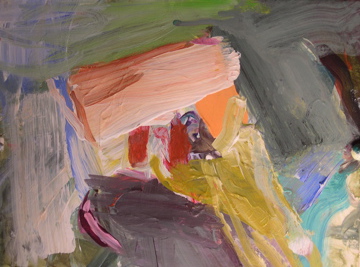 |
| From Sources Nov 2009 / sticks & stuff |
Acrylic on canvas, 6"x8"
Friday, November 20, 2009
Prayer for today

Acrylic on paper, 6"x8"
The Summer Day
Mary Oliver
Who made the world?
Who made the swan, and the black bear?
Who made the grasshopper?
This grasshopper, I mean-
the one who has flung herself out of the grass,
the one who is eating sugar out of my hand,
who is moving her jaws back and forth instead of up and down-
who is gazing around with her enormous and complicated eyes.
Now she lifts her pale forearms and thoroughly washes her face.
Now she snaps her wings open, and floats away.
I don't know exactly what a prayer is.
I do know how to pay attention, how to fall down
into the grass, how to kneel down in the grass,
how to be idle and blessed, how to stroll through the fields,
which is what I have been doing all day.
Tell me, what else should I have done?
Doesn't everything die at last, and too soon?
Tell me, what is it you plan to do
with your one wild and precious life?
---
This and other poems can be read on Poetry 180.
from New and Selected Poems, 1992
Beacon Press, Boston, MA
Copyright 1992 by Mary Oliver.
All rights reserved.
....
Saturday, November 14, 2009
Spooky
Had one of those strange coincidences occur yesterday. I had ordered a used copy of "Abstraction in the Twentieth Century: Total Risk, Freedom, Discipline". It arrived yesterday, and upon opening the front cover, I found an inscription. The inscription was not addressed to a particular person, but was dated 2/23/96 and signed "Happy Birthday". My birthday is 2/23. Hmmm.


Thursday, November 12, 2009
Research Paper - "The Subject Is the Object"
Jill Christian
Advisor: Laurel Sparks
Research Paper
6 November 2009
The Subject Is the Object
“You get bored with yourself and say, ‘what is it that I am interested in?’”
–Mary Heilmann, Interview, Art:21
This week I attended a graduate painting review at the University of New Mexico. The painting student Leslie Ayers presented paintings that were luscious, painterly large-scaled abstractions of interior spaces, with skewed perspectives and overlapping lines reminiscent of recent work by Amy Sillman. During the talk, Ayers was asked, “Is using the space simply a way that you can even make the painting at all?” While Ayers talked about wanting to create a space that can be inhabitable while expressing her particular fascination with the light and geometry of interior spaces, her painting seemed to be about the push and pull of space and color –- bringing you in enough (through perspective and color relationships) visually to engage your interest, yet halting your entrance through your unexpected encounter with a shifted plane, an opaque object, or advancing color. Although she understood her process as intuitive, she began her paintings with one-inch by one-inch thumbnail sketches, which she then blew up to letter size using a xerox machine. Her palette and grid-like structure of the compositions belied a logic and formal decision-making process that seemed more studied than intuitive and emotional. Was her subject matter a necessary and idiosyncratic springboard for painterly exploration rather than the true subject matter of her painting? Or both?
Listening to her presentation and the conversation of the student and faculty, I thought more about the question of subject matter in abstract painting and how painters use reference material to inform their work –- and to what degree it matters that these reference materials are visible to the viewer in the final work. How subject matter can serve as a scaffold, a jumping off point, or a way of disciplining or restraining the work with a project or question.
I’ve been thinking about subject matter and restraint during this semester because I encountered a severe block in my painting process when it was suggested that I shift to a different kind of reference material. My mentor suggested that I was taking on too much –- too much historical references; too much reference to images taken from books and magazines and combined together. That this all-overness is exacerbating the all-overness of my painting and preventing me from exploring basic concepts like the creation of visual space through push-pull, warm-cool, contouring, and size contrasts.
In my last paper, I discussed works by two minimalist artists, Udo Noger and David Brice. I was asked if there was something that these two artists have that I want for my own work. I think that what I responded to most in their work was a focus that allowed their paintings to explore a particular thing through a sort of project. I have begun researching how several abstract artists have used subject matter in their process as an aspect of focus; and ultimately as an expression of their particular interests. While painting in and of itself can be seductive, eventually, as Mary Heilmann said in an Art21 interview, “You get bored with yourself and say, ‘what is it that I am interested in?’.”
Mark Rosenthal discusses the dilemma of early abstractionists, in terms of Kandinsky’s questions, “What should replace the missing object?” He argues that this is the “crux of the dilemma for all abstractionists” and that “from the start, abstractionists needed to define their position with regard to subject matter, with each artist proposing his or her own solution” (Rosenthal 36). In spite of the formalism seemingly inherent in abstract painting, the subject has not gone away, and how a particular artist approaches subject matter is as important as (and influences) formal and process considerations. Amy Sillman echoes this sentiment in a Hammer lecture associated with the exhibition Oranges and Sardines, saying that “everything is absolutely idiosyncratic”.
Cecily Brown is one artist who relies on specific subject matter to create figurative, gestural abstractions. In her interview with Lari Pittman included in the 2008 exhibit catalog for the exhibit, Cecily Brown, she states that she begins with specific imagery in mind. “When I’m painting, I think figurally. I’ve started calling my paintings abstract narratives, because almost everyone who sees them says, ‘Oh, they’re so abstract.’ But when I’m making them, I need to know what it is that I’m painting; it has to be something very specific“ (Dore 28). Like many abstract artists, she expresses a certain degree of ambivalence about whether the viewer needs to know the sources of the work in order to fully experience the work. Brown says, “I don’t know whether I’ll indicate the subject in the title of these recent paintings or just not worry if nobody else sees the goat, or the flying monkey, or the tent, or whatever it is, and accept the subject as simply necessary to me in order to make a painting” (Dore 28). And perhaps knowing would lessen the visual experience of the viewer. Brown, for example, says that she frequently uses the shape of a tent as a beginning structure, but it serves more as an armature than an interpretable symbol within the world of the painting.
Merging and mixing sources is a frequently used strategy for many contemporary abstract painters. Brown suggests that it is the way she merges her sources into visual imagery that is what interests her: “I’m lost without having some kind of imagery from the outside world. But there’s never just one source. It’s the fusing of references that makes something new. And not just still visual images, but books, music, movies, TV -- they all help” (Dore 28). For Brown, the interest lies in creating something that doesn’t exist outside of the world of the painting, but which can take on life in her own mind -– and in the minds of her viewers. She defines a successful painting as one that is visually compelling enough that it “continues to review itself” over time. To her the importance lies in the creation of associations that stir memories –- "like daydreaming," she says (Dore 28).
Like Brown, Charline von Heyl talks about her method of abstraction as a desire to create something visually new and beyond the existing visual world. (Bell 93).
Whereas Brown seems to build up a multitude of images on the verge of recognition, von Heyl engages in a process of covering up. Von Heyl “would begin with a motif or image, and proceed to destroy it through a process of over-painting, until its origins were no longer recognizable and the activity of painting itself became the organizing principle for the canvas’s composition”(Bell 94). Unlike Brown, von Heyl claims that she does not have a pre-conceived idea when she begins a painting (although one could argue that a motif or image inherently carries ideas) and does not make studies. Instead she allows “the works to be determined rather by the decisions that arise in the process of their making” (Bell 95). However, von Heyl separately produces collage on paper, printmaking, and has created at least one artist book. If not explicitly translated into her paintings, it seems likely that these activities inform her subject matter.
Working in a very different and more “old-fashioned” (as she calls it) way is Amy Sillman. Sillman has pulled subject matter from the landscape and the figure, saying that she is interested in exploring the space between abstraction and figuration. Sillman’s work created for the exhibit, Third Person Singular, is based on very specific subject matter: drawings of couples in their environments. She chose the subject, not only to create a “exploration” for herself to “build a new vocabulary for form”, but also because of her interest in the built in psychological tension of couples. Like Brown and Heilman, she engages in a rearranging and working over of the original imagery. After drawing the couples from life, Sillman recreated drawings from memory. Describing her process in a the Hirshorn podcast, A Conversation with Amy Sillman, Sillman says:
For Sillman, though the work could not exist without the original subject matter, the interest lies in peeling away the particular of the subject matter that do not add to the imaginative interpretation of the subject, leaving those things that specifically interest and are peculiar to Sillman’s vision.
In the documentary film, Alice Neal, Alice Neal talks about her own figurative work and its relationship to abstract expressionism, which was the overriding style as she began her career. She says, “The human brain is incapable of inventing something they haven’t seen.” Similarly, Gary Garrels in the introductory essay to Oranges and Sardines says, “Painting as a physical phenomenon retains linkages to material existence, to the visceral, obdurate, and fragile characteristics of life. It reflects the body and mind, tied up into on indivisible knot (13). Brown, von Heyl, Sillman – as well as Leslie Ayers – are not so much making up something completely new, but by working with a range of subject matter creating new connections and ways of depicting, and thus seeing our world (the physical and psychological. These abstract artists all use their subject matter as a starting point, whether that is an interior architectural space, a motif, or a couple in relationship, and from there through manipulation, distortion, augmentation, and destruction create new visual realities that allow themselves and the viewers to see in a new way. As Brown says, a painting can create “an unpredictable situation where one sensation leads to another, so that looking at it becomes a complex and layered experience. I think the absence of fixed meaning is liberating” (Dore 29). In a strange way, such intense exploration of a particular subject matter can create new aesthetic and emotional experiences beyond the original meaning or source.
Works cited
Art:21 online video - Mary Heilmann http://www.pbs.org/art21/artists/mary-heilmann/
A Conversation with Amy Sillman (podcast), http://hirshhorn.si.edu/dynamic/podcasts/podcast_66.m4a
Bell, Kirsty. “It’s Own Reality.” Frieze, May 2009, p 92-97.
Dore, Ashton. Cecily Brown. New York: Rizzoli International Publications Inc, 2008. Print
Garrels, Gary. Oranges and Sardines: Conversations on Abstract Painting (exhibition catalog). Los Angeles: Hammer Museum, 2008. Print.
Rosenthal, Mark. Abstraction in the Twentieth Century: Total Risk, Freedom, Discipline. New York: Guggenheim Museum, 1996. Print.
Advisor: Laurel Sparks
Research Paper
6 November 2009
The Subject Is the Object
“You get bored with yourself and say, ‘what is it that I am interested in?’”
–Mary Heilmann, Interview, Art:21
This week I attended a graduate painting review at the University of New Mexico. The painting student Leslie Ayers presented paintings that were luscious, painterly large-scaled abstractions of interior spaces, with skewed perspectives and overlapping lines reminiscent of recent work by Amy Sillman. During the talk, Ayers was asked, “Is using the space simply a way that you can even make the painting at all?” While Ayers talked about wanting to create a space that can be inhabitable while expressing her particular fascination with the light and geometry of interior spaces, her painting seemed to be about the push and pull of space and color –- bringing you in enough (through perspective and color relationships) visually to engage your interest, yet halting your entrance through your unexpected encounter with a shifted plane, an opaque object, or advancing color. Although she understood her process as intuitive, she began her paintings with one-inch by one-inch thumbnail sketches, which she then blew up to letter size using a xerox machine. Her palette and grid-like structure of the compositions belied a logic and formal decision-making process that seemed more studied than intuitive and emotional. Was her subject matter a necessary and idiosyncratic springboard for painterly exploration rather than the true subject matter of her painting? Or both?
Listening to her presentation and the conversation of the student and faculty, I thought more about the question of subject matter in abstract painting and how painters use reference material to inform their work –- and to what degree it matters that these reference materials are visible to the viewer in the final work. How subject matter can serve as a scaffold, a jumping off point, or a way of disciplining or restraining the work with a project or question.
I’ve been thinking about subject matter and restraint during this semester because I encountered a severe block in my painting process when it was suggested that I shift to a different kind of reference material. My mentor suggested that I was taking on too much –- too much historical references; too much reference to images taken from books and magazines and combined together. That this all-overness is exacerbating the all-overness of my painting and preventing me from exploring basic concepts like the creation of visual space through push-pull, warm-cool, contouring, and size contrasts.
In my last paper, I discussed works by two minimalist artists, Udo Noger and David Brice. I was asked if there was something that these two artists have that I want for my own work. I think that what I responded to most in their work was a focus that allowed their paintings to explore a particular thing through a sort of project. I have begun researching how several abstract artists have used subject matter in their process as an aspect of focus; and ultimately as an expression of their particular interests. While painting in and of itself can be seductive, eventually, as Mary Heilmann said in an Art21 interview, “You get bored with yourself and say, ‘what is it that I am interested in?’.”
Mark Rosenthal discusses the dilemma of early abstractionists, in terms of Kandinsky’s questions, “What should replace the missing object?” He argues that this is the “crux of the dilemma for all abstractionists” and that “from the start, abstractionists needed to define their position with regard to subject matter, with each artist proposing his or her own solution” (Rosenthal 36). In spite of the formalism seemingly inherent in abstract painting, the subject has not gone away, and how a particular artist approaches subject matter is as important as (and influences) formal and process considerations. Amy Sillman echoes this sentiment in a Hammer lecture associated with the exhibition Oranges and Sardines, saying that “everything is absolutely idiosyncratic”.
Cecily Brown is one artist who relies on specific subject matter to create figurative, gestural abstractions. In her interview with Lari Pittman included in the 2008 exhibit catalog for the exhibit, Cecily Brown, she states that she begins with specific imagery in mind. “When I’m painting, I think figurally. I’ve started calling my paintings abstract narratives, because almost everyone who sees them says, ‘Oh, they’re so abstract.’ But when I’m making them, I need to know what it is that I’m painting; it has to be something very specific“ (Dore 28). Like many abstract artists, she expresses a certain degree of ambivalence about whether the viewer needs to know the sources of the work in order to fully experience the work. Brown says, “I don’t know whether I’ll indicate the subject in the title of these recent paintings or just not worry if nobody else sees the goat, or the flying monkey, or the tent, or whatever it is, and accept the subject as simply necessary to me in order to make a painting” (Dore 28). And perhaps knowing would lessen the visual experience of the viewer. Brown, for example, says that she frequently uses the shape of a tent as a beginning structure, but it serves more as an armature than an interpretable symbol within the world of the painting.
Merging and mixing sources is a frequently used strategy for many contemporary abstract painters. Brown suggests that it is the way she merges her sources into visual imagery that is what interests her: “I’m lost without having some kind of imagery from the outside world. But there’s never just one source. It’s the fusing of references that makes something new. And not just still visual images, but books, music, movies, TV -- they all help” (Dore 28). For Brown, the interest lies in creating something that doesn’t exist outside of the world of the painting, but which can take on life in her own mind -– and in the minds of her viewers. She defines a successful painting as one that is visually compelling enough that it “continues to review itself” over time. To her the importance lies in the creation of associations that stir memories –- "like daydreaming," she says (Dore 28).
Like Brown, Charline von Heyl talks about her method of abstraction as a desire to create something visually new and beyond the existing visual world. (Bell 93).
Whereas Brown seems to build up a multitude of images on the verge of recognition, von Heyl engages in a process of covering up. Von Heyl “would begin with a motif or image, and proceed to destroy it through a process of over-painting, until its origins were no longer recognizable and the activity of painting itself became the organizing principle for the canvas’s composition”(Bell 94). Unlike Brown, von Heyl claims that she does not have a pre-conceived idea when she begins a painting (although one could argue that a motif or image inherently carries ideas) and does not make studies. Instead she allows “the works to be determined rather by the decisions that arise in the process of their making” (Bell 95). However, von Heyl separately produces collage on paper, printmaking, and has created at least one artist book. If not explicitly translated into her paintings, it seems likely that these activities inform her subject matter.
Working in a very different and more “old-fashioned” (as she calls it) way is Amy Sillman. Sillman has pulled subject matter from the landscape and the figure, saying that she is interested in exploring the space between abstraction and figuration. Sillman’s work created for the exhibit, Third Person Singular, is based on very specific subject matter: drawings of couples in their environments. She chose the subject, not only to create a “exploration” for herself to “build a new vocabulary for form”, but also because of her interest in the built in psychological tension of couples. Like Brown and Heilman, she engages in a rearranging and working over of the original imagery. After drawing the couples from life, Sillman recreated drawings from memory. Describing her process in a the Hirshorn podcast, A Conversation with Amy Sillman, Sillman says:
I would try to redraw them. I thought those drawings were very funny because they were kind of distorted. And then the distortions made it really obvious that those drawings from memory were the real meat. Because they were the things that were linked to the obvious process of abstraction, but also draining the kind of boring content away and putting more interesting content in. Making it go from an act of perception to an act of imagination.
For Sillman, though the work could not exist without the original subject matter, the interest lies in peeling away the particular of the subject matter that do not add to the imaginative interpretation of the subject, leaving those things that specifically interest and are peculiar to Sillman’s vision.
In the documentary film, Alice Neal, Alice Neal talks about her own figurative work and its relationship to abstract expressionism, which was the overriding style as she began her career. She says, “The human brain is incapable of inventing something they haven’t seen.” Similarly, Gary Garrels in the introductory essay to Oranges and Sardines says, “Painting as a physical phenomenon retains linkages to material existence, to the visceral, obdurate, and fragile characteristics of life. It reflects the body and mind, tied up into on indivisible knot (13). Brown, von Heyl, Sillman – as well as Leslie Ayers – are not so much making up something completely new, but by working with a range of subject matter creating new connections and ways of depicting, and thus seeing our world (the physical and psychological. These abstract artists all use their subject matter as a starting point, whether that is an interior architectural space, a motif, or a couple in relationship, and from there through manipulation, distortion, augmentation, and destruction create new visual realities that allow themselves and the viewers to see in a new way. As Brown says, a painting can create “an unpredictable situation where one sensation leads to another, so that looking at it becomes a complex and layered experience. I think the absence of fixed meaning is liberating” (Dore 29). In a strange way, such intense exploration of a particular subject matter can create new aesthetic and emotional experiences beyond the original meaning or source.
Works cited
Art:21 online video - Mary Heilmann http://www.pbs.org/art21/artists/mary-heilmann/
A Conversation with Amy Sillman (podcast), http://hirshhorn.si.edu/dynamic/podcasts/podcast_66.m4a
Bell, Kirsty. “It’s Own Reality.” Frieze, May 2009, p 92-97.
Dore, Ashton. Cecily Brown. New York: Rizzoli International Publications Inc, 2008. Print
Garrels, Gary. Oranges and Sardines: Conversations on Abstract Painting (exhibition catalog). Los Angeles: Hammer Museum, 2008. Print.
Rosenthal, Mark. Abstraction in the Twentieth Century: Total Risk, Freedom, Discipline. New York: Guggenheim Museum, 1996. Print.
Tuesday, November 10, 2009
Sticks and a red rock
Started working with the sticks I collected. Here's the result:
12x12, acrylic on canvas
Thinking about: space through warm/cool, thin/thick. Not using straight out of the tube colors -- picked a combination of two complements, blue/orange and red/green with some blue/green and yellow. Made sure I mixed up a warm and a cool neutral using the complements. Also thought about brush stroke - large/small; slow/fast.
Listening to Be Good Tanyas, Po' Girl, Michelle Shocked, and The Duhks.
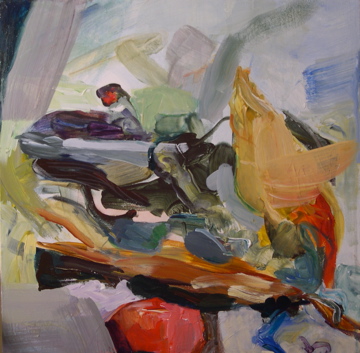 |
| From Sources Nov 2009 / sticks & stuff |
12x12, acrylic on canvas
Thinking about: space through warm/cool, thin/thick. Not using straight out of the tube colors -- picked a combination of two complements, blue/orange and red/green with some blue/green and yellow. Made sure I mixed up a warm and a cool neutral using the complements. Also thought about brush stroke - large/small; slow/fast.
Listening to Be Good Tanyas, Po' Girl, Michelle Shocked, and The Duhks.
Monday, November 9, 2009
Ghost Ranch and Rio Chama Sketches
Dave and I exchanged commitments at Chimney Rock on Saturday. We had a fantastic time hiking; the rest of the time he fished and I sketched/painted.
Here are some sketches (I was inspired by a UNM grad review -- Leslie Ayers to do some quick thumbnails; loved it!).
Here are some sketches (I was inspired by a UNM grad review -- Leslie Ayers to do some quick thumbnails; loved it!).
 |
| From Sources Nov 2009 / sticks & stuff |
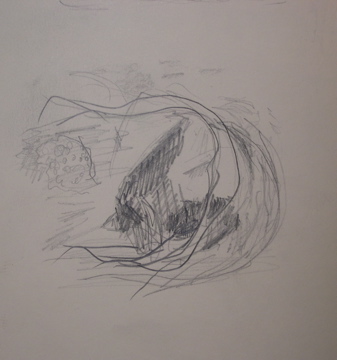 |
| From Sources Nov 2009 / sticks & stuff |
 |
| From Sources Nov 2009 / sticks & stuff |
 |
| From Sources Nov 2009 / sticks & stuff |
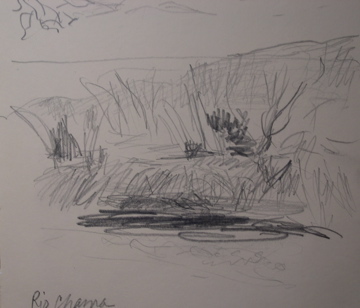 |
| From Sources Nov 2009 / sticks & stuff |
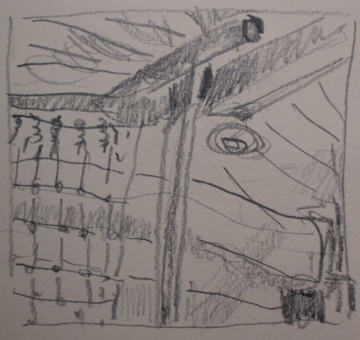 |
| From Sources Nov 2009 / sticks & stuff |
 |
| From Sources Nov 2009 / sticks & stuff |
 |
| From Sources Nov 2009 / sticks & stuff |
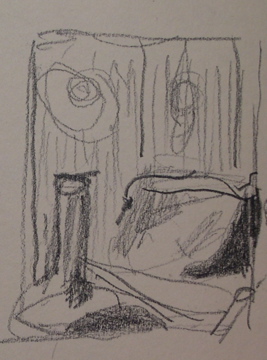 |
| From Sources Nov 2009 / sticks & stuff |
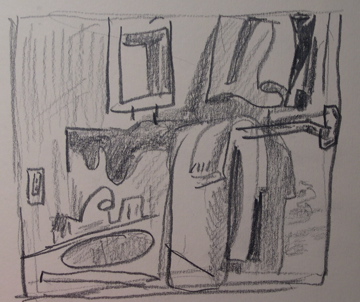 |
| From Sources Nov 2009 / sticks & stuff |
 |
| From Sources Nov 2009 / sticks & stuff |
Subscribe to:
Posts (Atom)